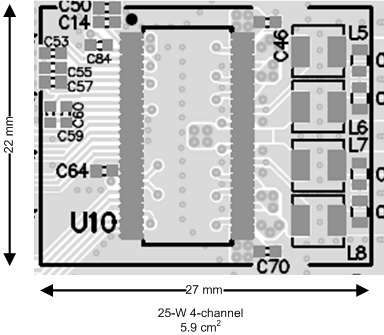JAJSM70A June 2021 – November 2021 TAS6424E-Q1
PRODUCTION DATA
- 1 特長
- 2 アプリケーション
- 3 概要
- 4 Revision History
- 5 Device Options
- 6 Pin Configuration and Functions
-
7 Specifications
- 7.1 Absolute Maximum Ratings
- 7.2 Recommended Operating Conditions
- 7.3 ESD Ratings
- 7.4 Thermal Information
- 7.5 Electrical Characteristics
- 7.6 Typical Characteristics: Bridge-Tied Load (BTL)
- 7.7 Typical Characteristics: Bridge-Tied Load (BTL, 384 kHz)
- 7.8 Typical Characteristics: Parallel Bridge-Tied (PBTL)
- 7.9 Typical Characteristics: Parallel Bridge-Tied Load (PBTL, 384 kHz)
- 8 Parameter Measurement Information
-
9 Detailed Description
- 9.1 Overview
- 9.2 Functional Block Diagram
- 9.3
Feature Description
- 9.3.1 Serial Audio Port
- 9.3.2 DC Blocking
- 9.3.3 Volume Control and Gain
- 9.3.4 High-Frequency Pulse-Width Modulator (PWM)
- 9.3.5 EMI Management Features
- 9.3.6 Gate Drive
- 9.3.7 Power FETs
- 9.3.8 Load Diagnostics
- 9.3.9
Protection and Monitoring
- 9.3.9.1 Overcurrent Limit (ILIMIT)
- 9.3.9.2 Overcurrent Shutdown (ISD)
- 9.3.9.3 DC Detect
- 9.3.9.4 Clip Detect
- 9.3.9.5 Global Overtemperature Warning (OTW), Overtemperature Shutdown (OTSD)
- 9.3.9.6 Channel Overtemperature Warning [OTW(i)] and Shutdown [OTSD(i)]
- 9.3.9.7 Undervoltage (UV) and Power-On-Reset (POR)
- 9.3.9.8 Overvoltage (OV) and Load Dump
- 9.3.10 Power Supply
- 9.3.11 Hardware Control Pins
- 9.4 Device Functional Modes
- 9.5 Programming
- 9.6
Register Maps
- 9.6.1 Mode Control Register (address = 0x00) [default = 0x00]
- 9.6.2 Miscellaneous Control 1 Register (address = 0x01) [default = 0x32]
- 9.6.3 Miscellaneous Control 2 Register (address = 0x02) [default = 0x62]
- 9.6.4 SAP Control (Serial Audio-Port Control) Register (address = 0x03) [default = 0x04]
- 9.6.5 Channel State Control Register (address = 0x04) [default = 0x55]
- 9.6.6 Channel 1 Through 4 Volume Control Registers (address = 0x05–0x08) [default = 0xCF]
- 9.6.7 DC Load Diagnostic Control 1 Register (address = 0x09) [default = 0x00]
- 9.6.8 DC Load Diagnostic Control 2 Register (address = 0x0A) [default = 0x11]
- 9.6.9 DC Load Diagnostic Control 3 Register (address = 0x0B) [default = 0x11]
- 9.6.10 DC Load Diagnostic Report 1 Register (address = 0x0C) [default = 0x00]
- 9.6.11 DC Load Diagnostic Report 2 Register (address = 0x0D) [default = 0x00]
- 9.6.12 DC Load Diagnostics Report 3 Line Output Register (address = 0x0E) [default = 0x00]
- 9.6.13 Channel State Reporting Register (address = 0x0F) [default = 0x55]
- 9.6.14 Channel Faults (Overcurrent, DC Detection) Register (address = 0x10) [default = 0x00]
- 9.6.15 Global Faults 1 Register (address = 0x11) [default = 0x00]
- 9.6.16 Global Faults 2 Register (address = 0x12) [default = 0x00]
- 9.6.17 Warnings Register (address = 0x13) [default = 0x20]
- 9.6.18 Pin Control Register (address = 0x14) [default = 0x00]
- 9.6.19 AC Load Diagnostic Control 1 Register (address = 0x15) [default = 0x00]
- 9.6.20 AC Load Diagnostic Control 2 Register (address = 0x16) [default = 0x00]
- 9.6.21 AC Load Diagnostic Impedance Report Ch1 through Ch4 Registers (address = 0x17–0x1A) [default = 0x00]
- 9.6.22 AC Load Diagnostic Phase Report High Register (address = 0x1B) [default = 0x00]
- 9.6.23 AC Load Diagnostic Phase Report Low Register (address = 0x1C) [default = 0x00]
- 9.6.24 AC Load Diagnostic STI Report High Register (address = 0x1D) [default = 0x00]
- 9.6.25 AC Load Diagnostic STI Report Low Register (address = 0x1E) [default = 0x00]
- 9.6.26 Miscellaneous Control 3 Register (address = 0x21) [default = 0x00]
- 9.6.27 Clip Control Register (address = 0x22) [default = 0x01]
- 9.6.28 Clip Window Register (address = 0x23) [default = 0x14]
- 9.6.29 Clip Warning Register (address = 0x24) [default = 0x00]
- 9.6.30 ILIMIT Status Register (address = 0x25) [default = 0x00]
- 9.6.31 Miscellaneous Control 4 Register (address = 0x26) [default = 0x40]
- 9.6.32 Miscellaneous Control 5 Register (address = 0x28) [default = 0x0A]
- 9.6.33 Spread-Spectrum Control 1 Register (address = 0x77) [default = 0x00]
- 9.6.34 Spread Spectrum Control 2 Register (address = 0x78) [default = 0x3F]
- 9.6.35 Spread Spectrum Control 3 Register (address = 0x79) [default = 0x00]
- 10Application and Implementation
- 11Power Supply Recommendations
- 12Layout
- 13Device and Documentation Support
- 14Mechanical, Packaging, and Orderable Information
パッケージ・オプション
デバイスごとのパッケージ図は、PDF版データシートをご参照ください。
メカニカル・データ(パッケージ|ピン)
- DKQ|56
サーマルパッド・メカニカル・データ
発注情報
3 概要
TAS6424E-Q1 デバイスは 4 チャネルのデジタル入力 Class-D オーディオ・アンプで、2.1MHz の PWM スイッチング周波数を実装しているため、非常に小さなサイズの PCB でコスト最適化されたソリューションを実現可能です。開始 / 停止イベントについて最低 4.5V で完全な動作を行い、最高 40kHz のオーディオ帯域幅で非常に優れた音質を提供します。
出力スイッチング周波数を AM バンドよりも高く設定すると、AM バンドの干渉を排除し、出力フィルタリングを減らしてコストを削減できます。また、AM バンドよりも低く設定すれば、効率を最適化できます。
デバイスには負荷診断機能が組み込まれており、出力の誤接続や、AC 結合されたツイータを検出して診断できるため、製造プロセスにおいてテスト時間を短縮するために役立ちます。
これらのデバイスには、スペクトラム拡散、出力位相オフセット、スルーレートの最適化など、システム・レベルの EMI 課題に役立つ EMI 管理機能が追加されています。
TAS6424E-Q1 Class-D オーディオ・アンプは、車載用ヘッド・ユニット、および外部アンプ・モジュールで使用するよう設計されています。1、2、4 チャネルのピン互換デバイスについては、「デバイスのオプション」の表を参照してください。
| 部品番号 | パッケージ(1) | 本体サイズ (公称) |
|---|---|---|
| TAS6424E-Q1 | HSSOP (56) | 18.41mm × 7.49mm |
 PCB 領域
PCB 領域